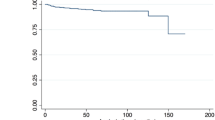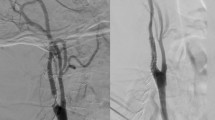Abstract
Background
Restenosis is a postoperative complication after carotid endarterectomy (CEA). The natural clinical course of restenotic lesions is not yet fully understood. This study was aimed at detecting the pattern of restenotic lesions by way of following the plaque thickness under duplex ultrasound, and the possible relationship between the postoperative changes of restenotic lesions and the preoperative plaque characteristics.
Method
Serial duplex ultrasound follow-up studies were conducted postoperatively, and intima-media thickness (IMT) was measured to detect restenosis changes. Among 381 cases of CEA, including 25 cases of restenosis, 11 were eligible for further analysis.
Findings
Of the 11 cases of restenosis, four showed a gradual increase in IMT, and five showed a temporary increase followed by a decrease in IMT. All cases in the former group showed isoechogenic or hypoechogenic plaques under preoperative duplex ultrasound. In contrast, all cases in the latter group demonstrated calcified plaques together with acoustic shadows.
Conclusions
These postoperative chronological IMT data demonstrate two changing patterns of restenosis, implying the existence of two distinct entities. In addition, these results suggest that restenosis after removal of a calcified plaque, which supposedly forms secondary to myointimal hyperplasia, may be a temporary phenomenon that acutely develops in response to a dissection maneuver during surgery. Because our speculation is based on a small number of cases, further study is warranted to better understand the pathophysiology of restenosis regression.


Similar content being viewed by others
References
AbuRahma AF, Abu-Halimah S, Bensenhaver J, Nanjundappa A, Stone PA, Dean LS, Keiffer T, Emmett M, Tarakji M, AbuRahma Z (2009) Primary carotid artery stenting versus carotid artery stenting for postcarotid endarterectomy stenosis. J Vasc Surg 50:1031–1039
Bernstein EF, Torem S, Dilley RB (1990) Does carotid restenosis predict an increased risk of late symptoms, stroke, or death? Ann Surg 212:629–636
Black JH 3rd, Ricotta JJ, Jones CE (2010) Long-term results of eversion carotid endarterectomy. Ann Vasc Surg 24:92–99
Chervu A (1995) Recurrent carotid artery stenosis: diagnosis, management, and prevention. Semin Vasc Surg 8:70–76
Fluri F, Engelter ST, Wasner M, Stierli P, Merlo A, Lyrer PA (2008) The probability of restenosis, contralateral disease progression, and late neurologic events following carotid endarterectomy: a long-term follow-up study. Cerebrovasc Dis 26:654–658
Hellings WE, Moll FL, De Vries JP, Ackerstaff RG, Seldenrijk KA, Met R, Velema E, Derksen WJ, De Kleijn DP, Pasterkamp G (2008) Atherosclerotic plaque composition and occurrence of restenosis after carotid endarterectomy. JAMA J Am Med Assoc 299:547–554
Hellings WE, Moll FL, de Vries JP, de Bruin P, de Kleijn DP, Pasterkamp G (2008) Histological characterization of restenotic carotid plaques in relation to recurrence interval and clinical presentation: a cohort study. Stroke J Cereb Circ 39:1029–1032
Hugl B, Oldenburg WA, Neuhauser B, Hakaim AG (2006) Effect of age and gender on restenosis after carotid endarterectomy. Ann Vasc Surg 20:602–608
Johnson CA, Tollefson DF, Olsen SB, Andersen CA, McKee-Johnson J (1999) The natural history of early recurrent carotid artery stenosis. Am J Surg 177:433–436
Kim DI, Moon JY, Lee CH, Kim DY, Jang YS, Kim GM, Chung CS, Lee KH, Kim SW (2007) Primary closure after a carotid endarterectomy. Surg Today 37:187–191
Lusic I, Radonic V, Pavelin S, Bilic I (2006) Is C-reactive protein a better predictor of recurrent carotid disease following carotid endarterectomy than established risk factors for atherosclerosis? VASA. Zeitschrift fur Gefasskrankheiten. J Vasc Dis 35:221–225
Mansour MA (1998) Recurrent carotid stenosis: prevention, surveillance, and management. Semin Vasc Surg 11:30–35
Miano JM, Vlasic N, Tota RR, Stemerman MB (1993) Localization of Fos and Jun proteins in rat aortic smooth muscle cells after vascular injury. Am J Pathol 142:715–724
Raftopoulos I, Haid SP (2000) Carotid endarterectomy with reimplantation of the internal carotid artery: perioperative risk, and incidence of recurrent stenosis in 167 procedures. Cardiovasc Surg 8:519–525
Reina-Gutierrez T, Serrano-Hernando FJ, Sanchez-Hervas L, Ponce A, Vega de Ceniga M, Martin A (2005) Recurrent carotid artery stenosis following endarterectomy: natural history and risk factors. Eur J Vasc Endovasc Surg Off J Eur Soc Vasc Surg 29:334–341
Samson RH, Showalter DP, Yunis JP, Dorsay DA, Kulman HI, Silverman SR (1999) Hemodynamically significant early recurrent carotid stenosis: an often self-limiting and self-reversing condition. J Vasc Surg 30:446–452
Schanzer A, Hoel A, Owens CD, Wake N, Nguyen LL, Conte MS, Belkin M (2007) Restenosis after carotid endarterectomy performed with routine intraoperative duplex ultrasonography and arterial patch closure: a contemporary series. Vasc Endovasc Surg 41:200–205
Sterpetti AV, Schultz RD, Feldhaus RJ, Hunter WJ, Bailey RT Jr, Hacker K, Davenport KL, Richardson M (1989) Natural history of recurrent carotid artery disease. Surg Gynecol Obstet 168:217–223
Conflicts of interest
None.
Author information
Authors and Affiliations
Corresponding author
Rights and permissions
About this article
Cite this article
Takami, H., Mizutani, T., Ota, T. et al. Spontaneous regression of restenosis after CEA: significance of preoperative plaque characteristics under duplex ultrasound; clinical investigation. Acta Neurochir 156, 63–67 (2014). https://doi.org/10.1007/s00701-013-1911-x
Received:
Accepted:
Published:
Issue Date:
DOI: https://doi.org/10.1007/s00701-013-1911-x




